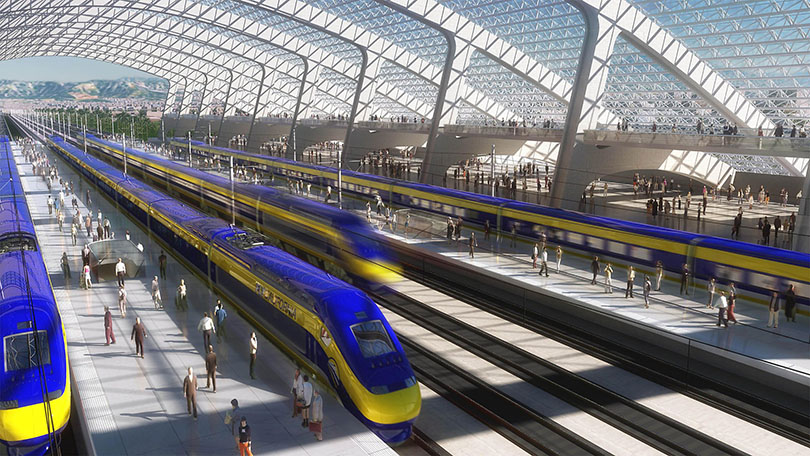
Rendering of the recently funded California HSR Fresno Station; source California HSR Authority
California High-Speed Rail
By building the California High-Speed Rail System, enhancing Amtrak California, and expanding Rapid Transit, the Golden State will join the Northeast Corridor leading America’s war against excessive regional flights, highway congestion, smog & greenhouse gas emissions. Infrastructure milestones are coming each year from 2023 and beyond. — Thomas Dorsey, Soul Of America
California High-Speed Rail (HSR) System is a mega-project on steroids. Phase 1 stretches about 500 miles from San Francisco to Anaheim. That’s longer than Interstate 95 from Boston to Washington, DC. Once Phase 1 is completed, California HSR will anchor mobility advantages that all Americans will covet.
Upgraded Amtrak California, enhanced Commuter Rail, and enlarging Metro Rail systems will complement it with more riders too.
Modeling California HSR After French HSR
California HSR follows a world-class model, the French HSR system named Train a’ Grande Vitesse, which translates to “High-Speed Train.” Commonly called “TGV”, it runs on legacy tracks in urban areas, then transfers to dedicated high-speed tracks called Ligne a’ Grande Vitesse, which translates to “High-Speed Line.” LGV has complete separation from automobiles & pedestrians, smooth track, and less curvature for higher speed and buttery rides.
Electric-powered TGV runs up to 186 mph on traditional LGV. Nextgen LGV has even less curvature for TGV to run up to 199 mph. When TGV transfers back from LGV to legacy tracks in urban areas, it sequentially slows to 124 mph, 112 mph, 99 mph, and 81 mph before stopping at train stations.
France and six other European countries let high-speed trains from other countries run on their HSR. Since High-Speed Train Operators compete like airlines there is ticket-fare competition. Passengers enjoy budget-to-premium fares competitive with airfare for regional flights. Though TGV fares vary by regional tourism season, they generally cost as little as $20 up to $80 to travel a few hundred miles. That’s significantly lower than Amtrak Northeast Corridor HSR fares.
As the leader of the Paris Climate Agreement, France is cutting GHG emissions faster by inducing higher TGV ridership to replace regional flights and more intercity drives. In late 2024, France will introduce a Nextgen high-speed train, whose generic name is Avelia Horizon, which will be more aerodynamic, 30% lighter, 20% more energy-efficient, and designed for 20% lower maintenance costs.
Avelia Horizon trains will be sold worldwide. In France, Avelia Horizon will be called “TGV M.” To serve the French PR objective of energy conservation, TGV M will initially be limited to 199 mph on Nextgen LGV.
This decade, France, Italy, and the European Union are constructing the world’s longest HSR tunnel under the Alps to connect France and Italy. Germany is building faster HSR from Frankfurt and Stuttgart to meet Nextgen LGV at the French border. Belgium is constructing more HSR mileage towards The Netherlands for shorter trip times and more frequent trains in the popular Amsterdam-Rotterdam-Brussels-Lille-Paris corridor. Fewer jets will fly between Amsterdam and Paris.
The eco-news from France is bigger than electric trains. To reach Net-Zero Emissions by 2050, France is banning new oil-powered automobiles by 2035 and replacing coal & natural gas with more low-cost wind & solar energy to fuel its Smart Electric Grid. Other European countries have more low-cost renewable energy entering their electric grids too.
France has banned domestic regional flights when alternative TGV & Regional Rail service exists. At the same time, long-distance flights (550+ miles) to France are increasing.
Post-pandemic train ridership is growing again. Though government-owned, TGV operates like a profit-motivated private entity. Those developments will give France and TGV management more incentive to boost TGV M to 211 mph this decade for more regional flight replacement, an extra daily roundtrip using the same staff, and higher operating profits.
France is completing more passenger rail milestones between 2024-35. It is upgrading most Regional Rail to support 124-137 mph speeds to smaller cities in the nation. The HSR tunnel will open between France and Italy to slash trip times between Paris and Lyon to Torino and Milan. A Nextgen LGV from Bordeaux opens to the 4th largest metro area in France, Toulouse. In Southern France, LGV completes expansion towards Spain to enable shorter trip times from Marseille, Lyon, and Paris to Barcelona and Madrid.
By 2033-34, France will anchor HSR service between the 150 largest cities of Western Europe. In my estimation, TGV M will be unleashed to 224 mph at that time for shorter trip times that replace even more regional flights.
California HSR Total Travel Time Advantages
The Central Valley of California HSR Phase 1 is being designed & constructed like Nextgen LGV for intercity drive and regional flight replacements in California, particularly between San Francisco and Los Angeles:
Non-Stop Trains 2 hours 40 minutes
Limited-Stop Trains 2 hours 56 minutes
All-Stop Trains 3 hours 15 minutes
As you see below, California HSR will provide game-changing trip time savings compared to driving and existing Amtrak California services.
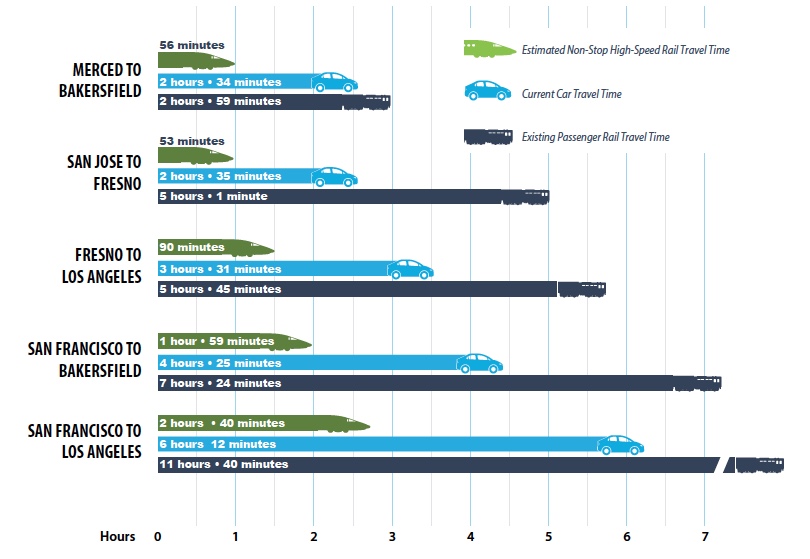 HSR Travel Time advantage over Cars & current Amtrak trains; source California HSR Authority
HSR Travel Time advantage over Cars & current Amtrak trains; source California HSR AuthorityAdd 30 minutes for California HSR rides that continue 33 miles south from Los Angeles to Anaheim.
California HSR Productivity, Relaxation & Reliability Advantages
Normally, you’d think that 450 mph regional flights have shorter trip times than high-speed train rides. The narrative changes, however, when the Airport Queues for flying are added.
Total Air Travel Time includes taking Uber/Lyft/Taxi/Family Drop-off to LAX or SFO airport 90 minutes before flights with these Airport Queues (security check, waiting to board, onboarding, origin runway taxi, destination runway taxi, off-boarding, and walking to curbside. If you check & pick up luggage, add 20-30 minutes) sandwiching a 52-55-minute flight time.
California’s Hub Airports counter some of that exhaustive Airport Queue time with WiFi, dining, and retail space to permit 30-45 minutes of productive or relaxation time before boarding. Once airborne, subtract 15 minutes after take-off and 15 minutes before landing as non-productive, non-relaxing time.
Since 2009, I averaged my Total Air Travel Time for SFO-LAX regional flights with carry-on luggage at 3 hours 45 minutes with about 75% schedule reliability. Then airlines started padding actual flight departure by 10 minutes to surpass 80% schedule reliability. SFO Airport has a lower schedule reliability percentage because fog conditions often cause them to slow down airplane arrivals & departures.
In summary, you get only 45-75 minutes of productive-relaxing time within 3 hours 45 minutes (avg.) Total Air Travel Time before reaching your intrastate destination. Hence, California is ripe for regional flight replacement by HSR.
Like French HSR train stations, California HSR stations will be new or upgraded to Intermodal Transportation Centers that handle large passenger volumes and support as many dining, retail, and service amenities as Hub Airports.
San Francisco and Anaheim already have such Intermodal Transportation Centers but await more HSR, Amtrak Regional, and Commuter Rail passengers. People who’ve downloaded train tickets on smartphones can arrive 10-15 minutes before train departure because security checks are brief and station platforms are level with train floors to make boarding fast. Each passenger stores small luggage above them or large luggage nearby in the same cabin, even when the train is moving.
The entire HSR ride can be productive in comfortable seats with large seat-back tables, WiFi, power sockets, and better seat lamps. Or, travelers can relax by watching videos, gazing through large windows at passing landscapes, and/or taking a power nap. Everyone can walk to the Cafe Car and restrooms at their leisure.
Once all San Francisco Bay Area and Los Angeles Metro Area railroad over/underpasses are complete, schedule reliability will reach 96-97%. Regional flights in California can’t match that schedule reliability.
California HSR Connectivity Advantage
The map below illustrates the unmatched transportation connectivity advantages that lie ahead. California HSR will anchor a passenger rail network that includes Amtrak California (Pacific Surfliner, Capital Corridor, San Joaquin) and Commuter Rail (Caltrain, Metrolink, ACE, COASTER). Brightline West HSR will run from Las Vegas to Rancho Cucamonga where it will connect with a Metrolink Station in San Bernardino County.
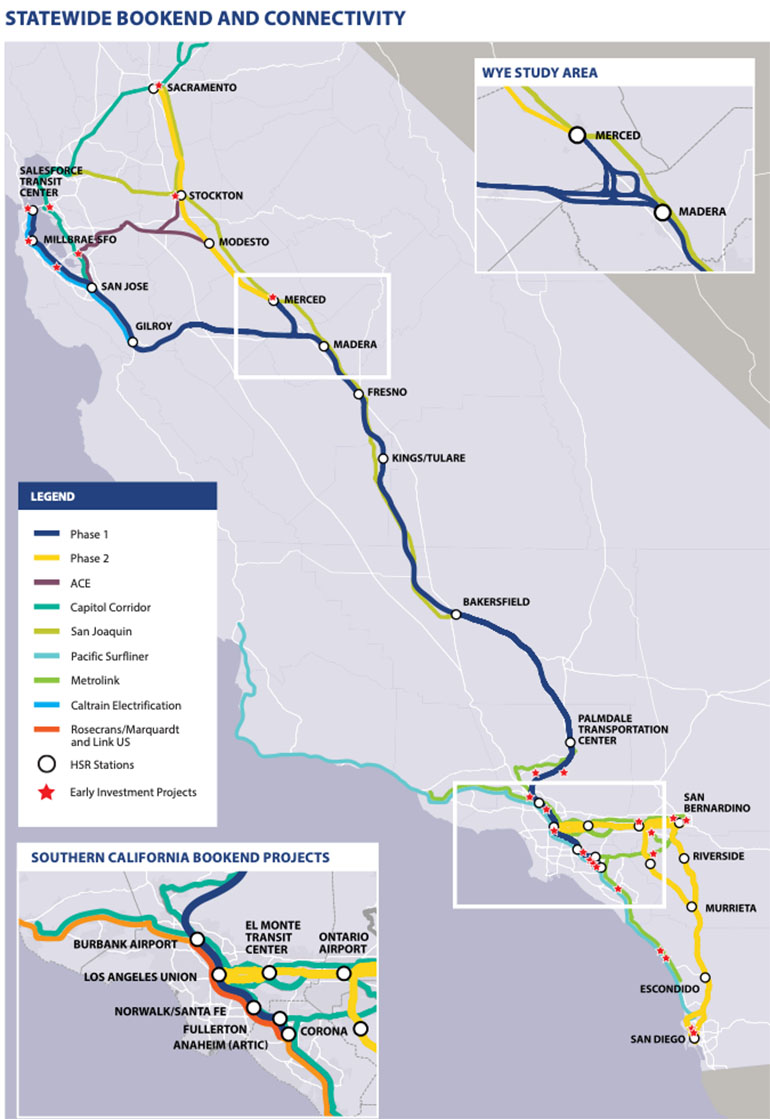
Map of existing & planned California HSR, Amtrak & Commuter Rail lines; source California HSR Authority
San Francisco-San Jose passenger rail segment and Burbank Airport-Los Angeles-Anaheim-Irvine-Oceanside-San Diego passenger rail segment are upgrading to what the industry calls “Regional Rail” status. Caltrain, Metrolink, and Amtrak will share that infrastructure with California HSR. This 3-minute explainer summarizes the coming advantages of Regional Rail and Enhanced Commuter Rail in California and their symbiotic relationship with California HSR.
Intercity Bus (Greyhound, Amtrak, FlixBus, LuxBus, MegaBus) lines stopping at the stations, then going to national parks and other places in the Urban Areas are not pictured above. Nor are Metro Rail lines in the Los Angeles Metro Area, San Francisco Bay Area, and San Diego Metro Area that will be 50-75% larger in 2040 than in 2020 enabling more rides to tourist attractions and activity centers.
When headed to Los Angeles Metro Area, San Francisco Bay Area, Sacramento Metro Area, or San Diego Metro Area, millions of travelers will have good options to reach final destinations without driving. Rental cars, Uber, Lyft, and taxis will remain available too.
By now you should be asking, what segments are under construction for California HSR Phase 1? Will each segment deliver rider benefits as they open? Why is the San Diego Metro Area important to California HSR Phase 1?
Before addressing those questions, this explainer assumes you agree with California HSR Benefits over Costs. If you doubt its compelling Benefits over Costs, spend 4 minutes reading this backstory, then proceed below.
California HSR System Phase 1 Mega-Project
Phase 1 is considered a mega-project because it has 3 geographic categories with large segments that cost multiple billion dollars each:
California HSR Central Valley
• Merced Wye-Fresno-Kings/Tulare-Bakersfield (171 miles)
The Central Valley geographic category has substantial mileage already constructed, rights-of-way acquisition nearly complete, and engineering designs underway for remaining mileage to prepare for construction.
California HSR Northern Bookend
• San Francisco-San Jose ($2.1 billion, 43 miles)
• San Jose-Gilroy ($4.6 billion ??, 33 miles)
• Gilroy-Merced Wye ($12.8 billion, 56 miles to Carlucci Road)
I place “??” beside the relatively low-cost $4.6 billion San Jose-Gilroy segment due to the current plan for advanced Quad Gate Systems at many railroad crossings, instead of viaducts, overpasses, underpasses & street closures. Today’s public tolerates many gated railroad crossings because fewer than 15 trains per day cross them. Viewed another way, 35-40 second Gate Waits by Automobiles & Pedestrians average less than 1 per hour.
That tolerance will change because the San Jose-Gilroy segment lies in a fast-growing suburban area that wants better Caltrain commuter rail service and new California HSR service. If most gated railroad crossings remain, the 2040 public will hate an order of magnitude more Gate Waits for automobiles & pedestrians (see below). Therefore, I anticipate the San Jose-Gilroy HSR segment will eventually separated from automobiles & pedestrians at higher construction costs.
California HSR Southern Bookend
• Bakersfield-Palmdale ($22.2 billion, 79 miles)
• Palmdale-Burbank Airport ($24.4 billion, 38 miles)
• Burbank Airport-Los Angeles ($1.4 billion, 13 miles)
• Los Angeles-Anaheim ($2.9 billion, 31 miles)
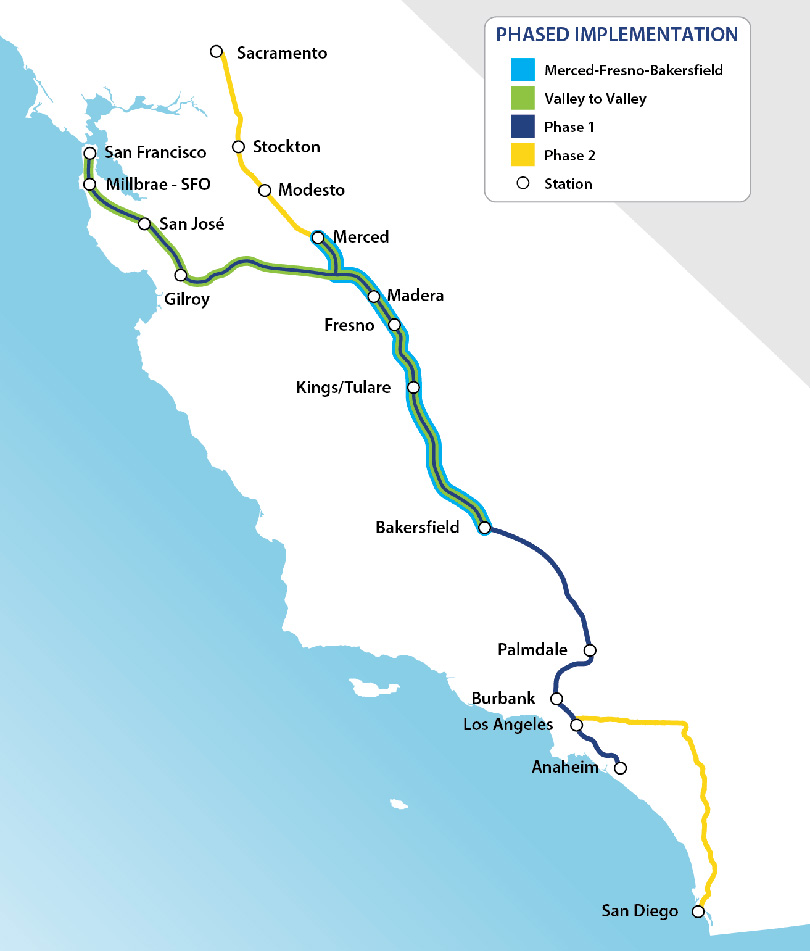
California HSR Phased Implementation Map; source California HSR Authority
With the recent $3.3 billion in federal grants, USDOT has contributed $6.8 billion (24%) to the California HSR mega-project over 2009-23. The State of California and affected counties have funded/will soon fund $21.7 billion (76%).
The San Jose-SFO Airport-San Francisco HSR segment has also been partially funded because that urban corridor needs Enhanced Commuter Rail speed & frequency before HSR arrives.
California HSR Authority’s next priority is to secure $5 billion more from USDOT within 2 years. Then it will have sufficient funds to complete the Merced Wye-Bakersfield segment and advance upgrades to the San Francisco-SFO-Airport-San Jose segment. Since another $21 billion is planned for USDOT dispersal nationwide, I am confident that California HSR will be granted at or close to that amount in 2-3 years.
Merced Wye-Gilroy-San Jose, Bakersfield-Palmdale, and Burbank Airport-Los Angeles segments are ready to build. Palmdale-Burbank Airport segment is on pace to become ready-to-build in 1Q 2024. But until the President and Congress approve more USDOT funding for Federal Railroad and Federal Transit projects, I’m not confident of their start dates for rights-of-way purchases, engineering design, and construction.
Why Build HSR in California Central Valley?
Many people mistakenly believe that the California HSR alignment should have traversed the I-5 Freeway for a more direct San Francisco-Los Angeles route. After all, that alignment could sustain 220 mph through flat Central Valley farmland to also enable the schedule mandated by the 2008 California HSR bond measure.
I’ve heard that comment based on a superficial understanding of the California HSR project many times. Here’s why that is under-informed thinking:
1. The actual 360-mile Central Valley Corridor (Sacramento-Stockton-Modesto-Merced-Madera-Fresno-Kings/Tulare-Bakersfield-Palmdale/Lancaster) was chosen because it had 6.4 million population, which is now 7 million. That’s a higher population density than several 350-mile HSR corridors in France, Germany, and Italy, and they don’t connect to 7 million and 19 million population metro areas. Furthermore, the Central Valley Corridor is projected to reach 8 million population by 2040. Those numbers make the Central Valley a smart choice for 2040 ridership forecasts by the California HSR Authority.
2. The Amtrak San Joaquin train from Sacramento and the Amtrak San Joaquin train from Oakland will transfer riders at California HSR Merced Station and generate higher ridership for California HSR sooner than waiting for tunnels to the Northern Bookend and Southern Bookend.
3. 1-hour access to less expensive Central Valley housing by workers in the San Francisco Bay Area and Los Angeles Metro Area. In case you don’t know, those big metro areas have a housing affordability crisis.
4. 1-hour access to San Francisco Bay Area & Los Angeles Metro Area jobs by Central Valley residents who need a lower unemployment rate.
5. Most airlines have stopped flying to the 500K to 1.3 million population Fresno, Bakersfield, and Stockton metro areas because they make higher profits on longer flights.
6. To avoid being an “Urban Elitist Project” it was smart politics to provide Central Valley service that gave its residents reason to vote for the 2008 California HSR bond measure. France, Italy, Germany, and Japan made similar political considerations to expand their successful HSR networks.
7. If the I-5 Freeway HSR alignment was chosen, it would require 25-30 miles of deep tunneling under mountains that peak at 4160 feet and cross the San Andreas Fault underground. In contrast, the California HSR Burbank Airport-Palmdale-Central Valley alignment requires significantly less tunnel mileage near the San Andreas Fault and crosses the fault above ground. Hence, the Burbank Airport-Palmdale alignment psychologically invites higher ridership.
Though not planned during the 2008 California HSR bond measure, having a California HSR Palmdale Station is serendipity. It invites a 53-mile Brightline West HSR extension from Victor Valley to Palmdale in the future. Brightline West wants that surface & viaduct extension to enable their high-speed trains to attract California HSR transfers from Northern Bookend and Central Valley travelers at California HSR Palmdale Station.
More importantly, a Brightline extension to California HSR Palmdale Station and the California HSR Authority plan to build Palmdale-Burbank Airport segment tunnel & viaduct will create faster 1-seat, 3-hour rides in the Las Vegas-Los Angeles corridor. Brightline will only need to license time slots on the California HSR track, which should enable fares to compete with flying. Based on Amtrak Northeast Corridor experience with mediocre HSR, those factors should cut LAX-Las Vegas and Burbank-Las Vegas flights by 70-75%, halve the intercity drives between LA and Las Vegas, and triple Brightline West ridership.
Central Valley Initial Operating Segment
Two Amtrak San Joaquin routes from Oakland and Sacramento run through the upper Central Valley to Merced, Fresno, and Bakersfield at 60-79 mph. Despite those slow train speeds, pre-pandemic Amtrak San Joaquins attracted a million annual riders.
California HSR’s Initial Operating Segment will connect those Amtrak San Joaquin trains to a new California HSR Merced Station enabling transfer to high-speed trains that continue down to Bakersfield. Simultaneously, HSR construction will extend several dozen miles west from Madera towards Gilroy then stop without a station just before a mountain range. Together, they form what the California HSR Authority calls the “Merced Wye.
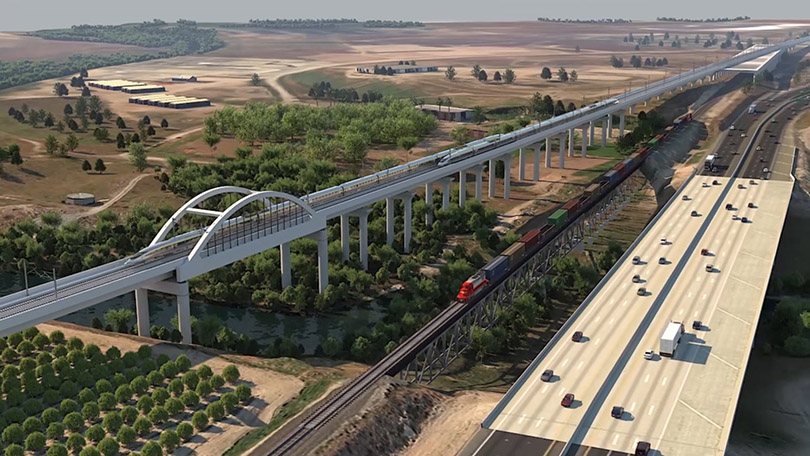
Nearly complete California HSR viaduct over San Joaquin River in the Central Valley; source California HSR Authority
In 2030, America will get its first taste of 220 mph HSR over 171 miles from California HSR Merced Station to California HSR Bakersfield Station in only 56 minutes.
The Central Valley segment will next need funding for the Merced Wye-Gilroy segment.
Northern Bookend Upgrades
In the Northern Bookend, federal, state & county funds are enhancing Caltrain commuter rail and expanding Metro Rail. By 2040, train stations will interconnect HSR, Caltrain Commuter Rail, Intercity Buses, Metro Rail, Bus Rapid Transit (BRT), Local Buses, Uber/Lyft, Taxis, and Dedicated Bikeways. Transportation planners generically call such train stations “Intermodal Transit Centers” or “Multimodal Transportation Centers.”
Salesforce Transit Center is such an Intermodal Transit Center in downtown San Francisco. It is an architectural tour de force with colorful interior space and a rooftop park embraced by residents, workers, and commuters. Salesforce Transit Center currently connects Intercity Buses, BRT, Local Buses, Shuttles, Uber/Lyft, Taxis, and Dedicated Bikeways. It has which has a pre-built underground level to host 6 passenger trains simultaneously.
Metro Heavy Rail (locally called “BART”) and Metro Light Rail (locally called “Muni Metro”) lines have an underground station 1 block away from Salesforce Transit Center. San Francisco Ferry Building is only a 3-block walk from Salesforce Transit Center.
Caltrain runs frequent commuter trains in the 49 miles between San Jose and San Francisco but stops 1.3 miles short of Salesforce Transit Center. A rail tunnel extension to Salesforce Transit Center is slated to commence construction in 2024, if federal and state funding is secured.
From 2009 to 2018, Caltrain experienced 80 collisions at the gated railroad crossings shared by trains, automobiles, cyclists, and pedestrians. The Federal Railroad Administration says 94% of train-vehicle collisions can be attributed to risky driver behavior or poor judgment.
In 2023, Caltrain powered by diesel locomotives is limited to 79 mph and averages 5 trains/hour, yet transported 65,000 daily riders. A few freight trains use the tracks after Caltrain’s 19-hour service day. Currently, 37 gated railroad crossings between San Jose and San Francisco limit Caltrain to 96 daily roundtrips. Caltrain and its city & county partners are installing sophisticated Quad-Gate Systems at railroad crossings that reduce opportunities for risky driver behavior and poor judgment. Quad-Gate Systems cost about $1M each.
In 2024, Caltrain will convert to electric trains that accelerate & brake faster. In lengthy sections completely separated from automobiles, cyclists, and pedestrians, speeds will increase to 90 mph to enable greater train frequency. As more railroad over/underpasses are built in the corridor, Caltrain will increase to 90-100 mph in some sections.
Over 2030-31, patrons from the Oakland side of the San Francisco Bay will enjoy a BART Metro Rail extension to the upgraded San Jose Diridon Station that also hosts Amtrak Capitol Corridor regional trains and Amtrak Coast Starlight long-distance trains.
The rail tunnel extension to Salesforce Transit Center will enable shorter trip times into downtown San Francisco. California HSR currently plans to run through 6 Quad-Gate Systems in the urban San Francisco-SFO Airport-San Jose segment. Cities will pay for the 4-5 planned street closures of railroad crossings between San Francisco and San Jose that cost $100,000 each. That will leave 26-27 railroad crossings that need over/underpasses. In 2023 dollar value, up to $2.7 billion is needed to build them. The suburban San Jose-Gilroy segment is aplanned to have a large TBD number of Quad-Gate Systems.
To sustain 100-110 mph throughout the Northern Bookend and further increase train frequency, high-speed trains must bypass commuter trains. Therefore, widening from 2 Main Tracks to 4 Main Tracks is needed at several strategic Caltrain stations between Gilroy, San Jose, and San Francisco.
It’s good that California HSR respects public input. But here’s why the 6 + TBD Quad-Gate System crossings in the combined San Francisco-SFO Airport-San Jose-Gilroy segment would likely be jeered by 2030 public and loathed by the 2040 public.
On a typical 2019 workday, up to 400,000 automobiles crossed Caltrain tracks. Some drivers were so frustrated by each 35-40 second “Gate Wait” at railroad crossings that they engaged in risky crossing behavior. Even with Quad-Gate Systems reducing bad driver behavior, some elderly pedestrians take longer than average to cross tracks. Unfortunately, some emotionally troubled people park vehicles on tracks too.
By 2030, Caltrain wants to provide commuters with 114 daily roundtrips between San Francisco and San Jose for 228 daily train movements that each trigger 35-40 seconds of Gate Wait that tortures drivers and emits more automobile smog for nearby residents & businesses. At the same time, Caltrain wants to provide commuters with 19 daily roundtrips between San Jose and Gilroy. Combined with 2 daily roundtrip Amtrak Coast Starlight trains and 4 daily freight trains, there would be 46 daily train movements triggering Gate Waits. Residents between San Francisco, San Jose and Gilroy will not be anxious to discover that California HSR will initially bring 76 more Gate Waits each day.
By 2040, Caltrain wants to provide commuters with 125 daily roundtrips between San Francisco and San Jose and 38 daily roundtrips between San Jose and Gilroy. California HSR wants to provide 76 daily roundtrips. Combine those roundtrips with 2 daily Amtrak Long-Distance roundtrips and 5-6 freight trains. There would be 326 daily train movements between San Jose and San Francisco and 230 daily train movements between San Jose and Gilroy triggering Gate Waits. I believe the 2028 public will demand more viaducts, overpasses, underpasses, and street closures to prevent Gate Waits by 2040.
Southern Bookend Upgrades
The Bakersfield and Palmdale have Ready-to-Build Intermodal Transportation Centers Station in planning and await funding. Palmdale Multimodal Transportation Center will connect Metrolink commuter trains, high-speed trains, intercity buses, Uber, Lyft, and Taxis.
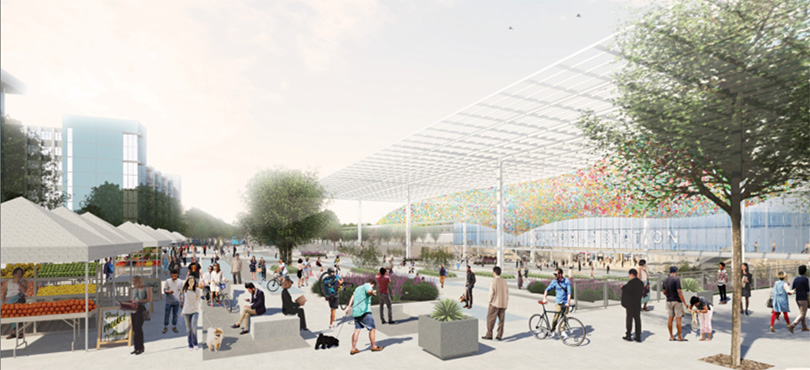
Palmdale Multomodal HSR Station rendering; source City of Palmdale
In the mountainous 38-mile Palmdale-Burbank Airport segment, tunnels & viaducts are required for trains to run up to 145 mph, similar to HSR tunnels in the Swiss Alps. As high-speed trains approach Burbank Airport, they will slow to 110-100 mph in the urbanized Burbank Airport-Los Angeles-Anaheim segment.
Burbank Airport plans to build a replacement terminal north of the current terminal by 2027. Once the Palmdale-Burbank Airport HSR segment is funded, Burbank Airport will help coordinate the construction of an underground station to host high-speed trains at walking distance to/from Burbank Airport Replacement Terminal.
Located on the edge of a fast-growing downtown, Los Angeles Union Station is the 6th busiest train station in America. It currently hosts Amtrak Pacific Surfliner, 2 Amtrak Long-Distance lines, 6 Metrolink commuter rail lines, 3 Metro Rail lines, many Bus Rapid Transit lines, Intercity Buses, Taxis, Uber, Lyft, and Dedicated Bikeway.
The 2009 California HSR bond, primarily consumed in the Central Valley, also helped fund the Regional Connector in Downtown LA enabling more Metro trains to reach Los Angeles Union Station. By 2027-28, two new railroad overpasses in Glendale and one in Santa Fe Springs will improve Metrolink lines and Amtrak lines headed to Los Angeles Union Station.
In 1939, Los Angeles Union Station was built as a terminus rather than a run-thru station. Consequently, trains to/from destinations south of Downtown LA must pull in and back out of Los Angeles Union Station, adding 6-10 minutes to train schedules.
In 2024, California HSR needs a lot more funds to finish upgrading Los Angeles Union Station with run-thru tracks, wider concourses, a new canopy over train platforms, and passenger amenities to complete by 2030. In 2025, the Los Angeles-Anaheim segment will be ready-to-build.
About 14 miles southeast of Los Angeles Union Station, Norwalk/Santa Fe Springs Station currently hosts Metrolink commuter trains. Amtrak California is adding more trains. LA Metro Transit Authority owns the station and plans for a major capacity upgrade, hopefully by the 2028 Los Angeles Summer Olympics.
That will LA Metro in pursuit of more federal & state funding for a 2-mile LA Metro Light Rail extension to Norwalk/Santa Fe Springs Station making it suitable for many more Metrolink riders, new riders from Amtrak Pacific Surfliner, and new riders from LA Metro Rail. Such a project is even more attractive because the Light Rail connects to LAX Airport.
Those rider-generating projects may make Norwalk/Santa Fe Springs Station an attractive optional station for California HSR.
Anaheim Regional Intermodal Transit Center (ARTIC) has attractive interior space and room for an order of magnitude more passengers and retail activity. To reach ARTIC and grow from 41 daily trains today up to a planned 241 daily trains by 2040, that segment should get at least 7 over/underpasses, 2 street closures with at most, 1 Quad-Gate System.
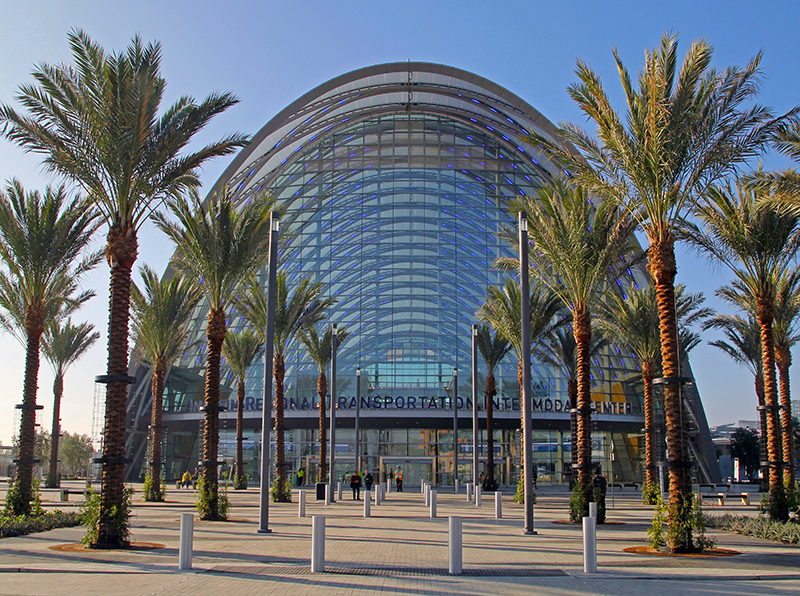
Anaheim Regional Transportation Intermodal Center (ARTIC); (c) Soul Of America
USDOT recently awarded $3.3 billion in grants to California HSR Central Valley projects plus $3 billion to Brightline West HSR that will be spent between Victor Valley and Rancho Cucamonga, California. The USDOT describes them as 2 years of funding. We can now be confident that 171 miles of California HSR in the Central Valley and 218 miles of Las Vegas-Rancho Cucamonga service will open in 2029-30.
California HSR mega-project has 320 additional Ready-to-Build miles and more stations that need funding. Over a dozen railroad over/underpasses are needed in the Burbank Airport-Los Angeles-Anaheim segment too.
Critical Passenger Rail Segments Need More Funding
Based on my studies of French HSR, Amtrak Northeast Corridor HSR, and the 2022 California HSR Authority Segment Cost Estimates, I can see a path for Phase 1 to complete by 2038, if enough funds are secured this decade.
The public won’t have to fund it all. Privately-owned Brightline West has already committed over $8 billion investment in the Las Vegas-Rancho Cucamonga HSR project which is only projecting 12 million annual ridership, while California HSR Phase 1 projects 40 million annual ridership.
Once California HSR San Francisco-Bakersfield and Merced-Bakersfield Brightline segments are fully funded and partially operational, don’t be surprised if a private entity steps up to fund the California HSR Bakersfield-Palmdale segment in exchange for exclusive rights to operate their trains on the California HSR route. It would be financially feasible because California HSR San Francisco-Palmdale segment would connect to Metrolink commuter rail, like the current Brightline West HSR project to Rancho Cucamonga, but it would attract more than 12 million annual riders.
Freight Rail companies will also spend up to $1 billion on Siding Track to separate freight trains from passenger trains. Based on the Transit-Oriented Development success of the San Francisco Salesforce Transit Center before Caltrain and California HSR arrive, we can also anticipate about $2 billion from TOD and naming rights at other large HSR stations. Many HSR advocates ponder the possibility of Google paying for naming rights at San Jose Diridon Station since it is building a giant village next to it.
Anaheim-Oceanside-San Diego Regional Rail corridor is closely related because California HSR, Metrolink commuter rail, and Amtrak Pacific Surfliner will share right-of-way in the Burbank Airport-Los Angeles-Anaheim segment. Metrolink continues south of Anaheim through southern Orange County to Oceanside in northern San Diego County where it meets with COASTER commuter rail. Amtrak Pacific Surfliner continues south of Anaheim serving Orange County and the 3.4 million population San Diego metro area. It is the second busiest Amtrak corridor but has only scratched the surface of its ridership potential.
The increase in winter storms have caused more bluff failures that halt Amtrak and COASTER commuter rail service. Metrolink and COASTER commuter rail also needs shorter trip times in the combined Burbank Airport-Los Angeles-Anahiem-Oceanside-San Diego corridor. For that reason, Los Angeles County, Orange County, San Diego County, Federal Railroad Administration, Amtrak, Federal Transit Administration, and California State Transportation Agency (CalSTA) are combining funds to upgrade that corridor too.
Politics of Federal and State Passenger Rail Funding
For decades USDOT has spent 5-6 times more on Highways than Transit and Passenger Rail combined. In response, California State Transportation Agency (CalSTA) Highway Division’s annual budget has risen $16 billion per year in part to match $1 of state funding for every 2 dollars received from USDOT’s Federal Highway Administration. Affected counties typically contribute 10 to 20 cents for each $2 of Highway funding.
On the surface, that funding formula works well for highway & bridge maintenance. It becomes troublesome, however, when you realize that several billion dollars per year of federal, state & county funding goes to Highway Widenings that induce more people to drive. Moreover, they are widening highways faster than we can build better Rapid Transit and Passenger Rail alternatives.
Consequently, highway congestion remains high in California. Each summer, Global Warming is making the state a little hotter and wildfires more frequent. California has the most metro areas with high-smog-levels. In response, the state is using the Greenhouse Gas Reduction Fund as the main source of California HSR’s budget going forward. Unfortunately, federal and state funding sources are insufficient and MUST change their Transportation funding priorities.
On paper, California HSR, Amtrak Regional Rail, and Commuter Rail projects are well positioned to win more USDOT grants based on several factors:
• California and its counties contribute the most funds to match USDOT grants
• California Passenger Rail projects are eligible to compete for $57 billion in 6 categories of USDOT grants
• California Passenger Rail projects have the most Ready-to-Build mileage
• California Passenger Rail projects have the most congressional support of any state
Voters born after 1981 care deeply about Global Warming and have a lower Car Ownership Percentage than earlier generations. California HSR project approval has grown to 56%, with over 60% approval from age 18-40 voters. Polls consistently indicate that voters born after 1981 also want better Amtrak Regional Rail, Commuter Rail, Metro Rail & BRT service.
The impact of age 18-40 voters born after 1981 was felt in California’s 2022 Election. Aged 18-46 citizens will be the majority of voters in the 2024, 2026 & 2028 Elections. They can pressure the president, congressmen, governor, state legislators, and county commissioners to invest in more Passenger Rail and Rapid Transit projects aligned with policies to:
• End Highway Widening in California (and other states) when current projects complete by 2025-ish
• Triple California HSR, Amtrak Regional Rail, Commuter Rail & Metro Rail project funding
• Limit remaining CalSTA Highway budget to bridge & surface repair
The rail corridor shared by California HSR System Phase 1 needs $50 billion more USDOT funding, $11 billion more state funding, and $4 billion more county funding to attract $18 billion in private funding from a High-Speed Train Operator, Transit-Oriented Development & freight rail company sources. If you divide the $65 billion public number by 11 years counting from 2024-35, the project needs to average $6 billion/year in total public funding.
If multiple segments are built continuously at the same time, the San Francisco-SFO Airport-San Jose-Gilroy-Madera-Fresno-Tulare/King-Bakersfield-Palmdale-Burbank Airport-Los Angeles-Anaheim HSR mega-project + Anaheim-Irvine-Oceanside-San Diego Regional Rail project can both complete by 2038. They will boost each other’s ridership.
There’s a huge payoff for Californians and visitors to the state. By 2040, Los Angeles Metro Area, San Francisco Bay Area, and San Diego Metro Area will have fairly robust Rapid Transit systems that help California’s Passenger Rail lines meet a 1.3 million daily riders forecast. Collectively, they can represent 450-475 million annual Passenger Rail trips taking a huge bite out of 550 million annual intra-state trips forecast by 2040.

When is the California High Speed Rail going to be completed?
This mega-project did not receive federal funding from 2011 to 2021. If Congress and President Biden fund two big segments over 2023-28, private funding will contribute a few years down the road, as it has in Florida and Las Vegas-Southern California Passenger Rail projects. Under those conditions and given many geological unknowns for tunneling, we estimate that California HSR Phase 1 “COULD” complete by 2038.
California HSR Phase 2 extensions to San Diego and Sacramento will not start until California HSR Phase 1 nears completion.
Thank you for sharing informative content. It means a lot to me hope you do more articles to post.
We’re waiting to see how much USDOT funds are allocated to the California HSR Phase 1 mega-project. It needs at least $15 billion/6 years, though $20 billion is preferred and closer to the $30 billion going to Amtrak Northeast Corridor HSR & Keystone HSR routes.